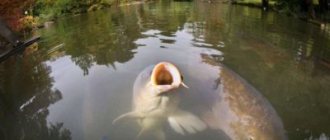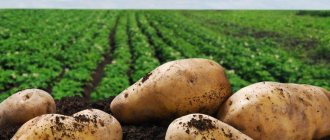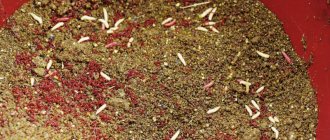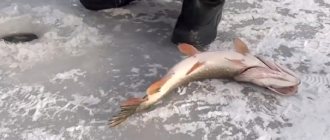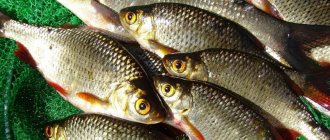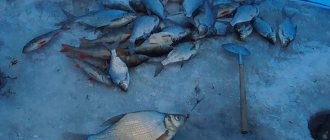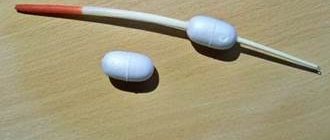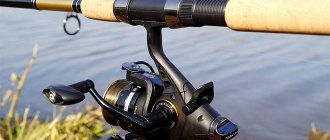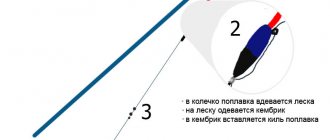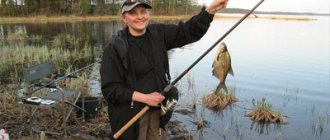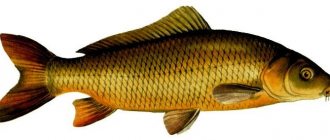Based on all seasons, fishing for carp in the spring is the most effective. After a long winter, when the fish was not active, it begins to gain strength and feed purposefully.
At the same time, it was noted that on rivers, carp awakens from hibernation faster after winter than it itself and its closest relative, carp, on closed ponds. The current allows the reservoir to quickly clear the ice cover, and the sun's rays warm up the shallow water earlier.
Where to look for carp in spring
Taking into account the warming of the reservoir, the fish come out of the pits where they spent the winter. Catching carp in the spring is possible when the water in the river warms up to 14-16 C. At the same time, the carp is not yet very active, so bites are more sporadic.
A stable bite is observed if the water temperature rises to 18-20 C. In spring, wild carp should be looked for in the following places:
- where there is a hard bottom, mollusks live;
- comes out into shallow water near reed thickets;
- places with a clay bottom near pits with snags;
- near islands of aquatic vegetation;
- small tributaries flowing into the river.
The easiest way to find a school of carp is to arrive at dawn. When it warms up, fish often walk on the surface of the water, revealing themselves with loud splashes. Then the carp goes to depth, and it is in this place that the equipment needs to be thrown. As a rule, fishing is done at a depth of 5-6 meters.
Typical carp sites on a spring river while the water is still relatively cold
Habitats and fishing zones for wild carp
This species of ichthyofauna inhabits small and large rivers, wild lakes, and reservoirs. Carp reaches a weight of more than 35 kilograms, but in catches there are individuals no more than 15 kilograms.
The weight of the prey directly depends on the fishing method. Thus, small specimens are more likely to be pecked on a float rig, while bottom rigs are capable of catching mature prey.
The fish spend the entire winter in wintering pits, accumulating in large groups. When the water warms up, the carp moves to smaller areas and gradually begins to lead an active lifestyle. Large individuals live in groups of up to five representatives of the carp family. Most often in a flock there are specimens of the same size.
Depending on the year, the fish start biting earlier or later. Weather conditions and the speed of the arrival of spring affect carp primarily. In April it is caught on dumps and exits from pits. In stagnant bodies of water, wild carp are found in the upper reaches, where the water warms up the fastest.
Promising places for catching carp on rivers:
Long pits
As a rule, it can be located on any part of the dump. In April it is best to explore the deepest zones, and closer to May you should move to the exits from the pits. The tackle is installed at the lowest point of the dump, under the last step. The carp takes refuge there from the current, gaining strength.
Snags at a depth of 3 meters
Sunken trees, stumps and branches provide excellent cover for fish and a home for food sources. Carp often gnaws at branches on which snails and insect larvae live. Fishing in such places must be done with caution, using strong gear. A strong opponent instantly disappears into the snags, from where it is not easy to get him out. When using a powerful fishing rod and a strong cord, the struggle does not last long; the angler, as a rule, pulls out the carp “unpretentiously”.
Sharp turns of the river
A strong current at turns washes out the opposite bank, creating an optimal depth for carp. In such places there are rarely hooks in the form of snags, but there is a water lily, which complicates fishing. In April the vegetation is low and sparse, making the turns an ideal spot for spring fishing.
See also: Rescue of pikes on kukan
Shell dumps
Mollusks make up a significant part of the food supply of underwater inhabitants. Both peaceful fish and predators feed on them. The sharp edges of the shell often cut fishing line and thin cord, so you should use a shock leader several meters long.
deep sea backwaters
The best place for float fishing is considered to be deep zones with minimal current. The backwaters are located near the shore and are part of the wintering pits. The depth in them, as a rule, is an order of magnitude less than in the riverbed, but the lack of current attracts large fish to such zones.
When fishing on a wild lake, you should be guided by a combination of factors that influence the location of the carp: depth, type of bottom, shelter and food supply. If a promising place has all the matching features, then the chances of catching a representative of the carp family increase.
What gear to choose for catching spring carp
Catching carp in the spring involves using a donkey feeder or a float rod (much less often). Taking into account the specifics of fishing, a feeder rod is usually selected.
Feeder equipment
The equipment of a feeder fishing rod usually looks like this:
- fishing rod, 3.9 meters long, with casting up to 90-110 grams;
- power reel, with spool size 4500 and baitrunner;
- monofilament, section 0.25-0.28 mm;
- hooks No. 6-8 according to the international classification;
- leash made of cord, cross-section 0.12-0.14 mm.
The equipment is used taking into account individual preferences, as a rule, it is an asymmetrical loop and a Gardner.
Feeder feeders are selected taking into account the current on the river. For quiet bodies of water, you should pay attention to plastic springs in the form of a cylinder. For fishing in moderate currents - metal mesh. For fishing in places with strong currents - heavy steel springs.
Asymmetrical loop - feeder equipment
Float
It makes sense to fish with a float if the fish is close to the coastline; this is generally more typical for fishing for carp in early spring in March-early April. The actual design looks like this:
- fishing rod, 3-4 meters long;
- reel with a spool size of 1500-2000, it is advisable to purchase models with a baitrunner;
- monofilament, section 0.22-0.28 mm;
- float with extended antenna;
- leash made of braided cord, diameter 0.12-0.16 mm;
- hooks No. 6-8 according to the international classification;
- under-grazing, which are used as pellets for loading the float.
Which float equipment to choose and use will depend on the fishing conditions. For example, you can choose the simplest fly fishing rod, but with the condition of its increased strength.
For fishing for carp in the spring on the current, it is recommended to choose a Bolognese rig, which will allow you to carefully float the bait, that is, bring it to the intended area on the reservoir where wild carp is located.
Plug and match
If space is limited, then it is best to choose a plug. In addition, this type of rod makes it possible to silently send complementary foods thanks to a specially installed bowl.
If the fish moves away from the shore, then a match rod is used, which makes it possible to easily cast over a long distance; this can be quite important towards the end of spring - beginning of June.
Catching carp in the spring, as well as catching other fish, has its own characteristics. For many fishermen, fishing for carp in the spring, throughout the warm season, is primarily a hunt for trophies.
Content:
Searching for carp in spring
Tackle and equipment
Tactics and techniques for catching spring carp
After all, carp can reach significant weight and size. Sometimes fishermen manage to catch a specimen weighing 25-30 kg. However, in modern times this does not happen often.
Carp is the wild ancestor of the well-known carp. Outwardly, it differs somewhat from its “domesticated” relative, primarily in its elongated body. And the body of carp has a more rounded shape. The body of the fish is golden in color and covered with large scales.
Carp prefers warm water and is attached to its favorite habitats. Large specimens lead an isolated lifestyle and never gather in flocks, unlike their smaller relatives. Wild carp are unpretentious to food and always find enough food for themselves, so the fish is characterized by accelerated growth.
Searching for carp in spring
Successful fishing for carp in the spring is possible if the angler knows exactly where to catch this large fish. Of course, carp is a heat-loving fish and is mainly purposefully caught in the southern part of Russia and in the central regions. But its distribution area is quite large and it happens that this fish is even caught in some rivers of the Kola Peninsula. In addition, carp lives in reservoirs and lakes.
In Southern Russia, carp fishing begins around the second half of April. As a rule, by this moment the water there has already warmed up enough and the carp began to actively feed in shallow areas of reservoirs. In the shallows, the water is warmest and carp come out of their wintering holes to soak in the warm water and look for suitable food. In the early morning and at night, loud splashes can be heard in some places on rivers and lakes. This is the first sign that carp is present there. The fisherman should remember such places, since fishing for carp in the spring can be very productive there.
You should also look for this fish in snags, in areas where there are steep banks, on the edges of dumps at depth. Carp loves peace and tranquility, so you should not look for it in places where there is a strong or moderate current. The best places to search for it are stagnant areas of reservoirs or places where the current is weak or moderate.
In quiet creeks and bays it can be found at the junctions of aquatic vegetation and clean water. Fishing for carp in the spring will be very promising there because it feeds there from sunrise until 9 am, and with the onset of dusk for the first part of the night.
If a fisherman finds a place with an abnormal bottom, it should attract his attention. If, moreover, it is covered with silt, and even more so with shell rock, it means that this place is promising and it is quite possible to catch carp there.
Tackle and equipment
Many consider the feeder to be the most effective tackle used for catching carp. This is probably due to the physiological structure of the fish. Its large mouth allows it to suck in mud during feeding, which contains various shells, larvae and crustaceans.
A feeder for catching carp is, first of all, a reliable and powerful rod, having a test value of at least 90 g. It is equipped with a powerful carp reel with a supply of strong fishing line or braided cord of at least 100 m. The equipment should allow for sufficiently long and accurate casts. A feeder and a leash with a hook are attached to the base. For fishing in places where there is no current, you need a feeder with a carrying capacity of 50 g. And for fishing in places with a current of 80 g or more, everything depends on the power of the current.
Fishing for spring carp can also be done with a float rod . This should be a long and durable fishing rod with a reliable spinning reel and a fishing line with a cross-section of 0.28 mm, with high tensile strength. The hook on such equipment should have sizes from No. 5 to No. 7.
They also catch carp with a bottom bait, where bells or a bell play the role of a signaling device. Another option for bottom gear used to catch carp is a makushatnik. In this case, hooks are attached to a metal plate and hidden in the bait.
Tactics and techniques for catching spring carp
The key to any success is thorough preliminary preparation. The same applies to catching carp. In addition to debugging the equipment, it is necessary to select the baits and bait mixtures . The peculiarity of catching carp in the spring, as well as in other seasons, is to cut off small fish from bites.
The first step is to properly feed the promising point. Thus, the carp should concentrate on the feeding point. In specialized stores you can buy carp bait, consisting of coarse-grained components that will be too tough for small fish. But it is much cheaper to prepare bait with your own hands based on a variety of cereals.
For example, it could be a mixture of steamed pearl barley or wheat and crackers. You can make bait mixtures based on peas or corn, etc. It is important that one of the components of the bait matches the bait on which carp will be caught in the spring. If pearl barley appears as bait, then it must be present in the bait. The same applies to wheat, corn or peas. It is also recommended to add flavors to the bait, preferably with sweet smells, vanilla, honey, caramel and others. Cake or crushed roasted seeds are also an excellent flavoring agent that should be added to bait.
At the fishing site, the bait is mixed with shore or bottom soil and formed into balls. The stronger the current, the higher the density of the balls should be. In still water, the balls should not be dense; they should crumble easily. It is recommended to bait the fishing point about an hour and a half before the start of fishing.
If fishing for carp takes place in the current, then it is necessary to form dense balls. They must be delivered to the water the night before or at night, and at dawn you can start fishing.
In addition to various grains, catching carp in the spring can be done with a worm or maggot. In this case, you need to bait the hook with a bunch of maggots or worms, if they are small, or one large worm. At dawn, if the place is chosen and fed correctly. The carp's bite can begin approximately 10-15 m after casting the tackle. If the fish ends up on the hook after successful hooking, you need to avoid unnecessary fuss and give slack to the fishing line. Despite its strength, the carp is not very durable and will soon get tired. At this time, it should be dragged to the shore. To catch such a large fish as carp, you should always have a landing net at hand, otherwise it will be a shame if the prey breaks the line almost at the shore.
Video: Catching carp
Did you like the article? Share with your friends!
0
Choosing bait/bait and groundbait - what smells does carp like in spring?
In the spring, in order to stir up relatively passive fish, a large number of animal and plant baits and a variety of baits are used.
Corn
To catch carp in the spring, you can use corn in cans, which is sold in any supermarket. But in this case, there is a high chance that small things will fit onto the bait spot.
Steamed corn is also used to catch carp. The cooking recipe is as follows:
- the grains are soaked for a day in water;
- then you need to boil the corn in the same liquid for about 15 minutes;
- Then the container is removed from the stove, covered with a lid and steamed for about 2 hours.
The prepared bait is placed on a hair rig or 2-3 grains are put on a hook.
Hair snap is allied with corn
Polka dots
Peas are good to use when catching carp in the spring on a donk from the shore. Fishing is especially successful with the help of the Turkish type of this pea - chickpea. Its grains are larger than ordinary peas, and this is much better suited for targeted fishing for trophy carp. This bait simply cuts off small things.
The cooking recipe is as follows:
- The grains are poured into an enamel container.
- Soak in water for one night.
- Installed on the stove.
- Let it boil.
- Then put in a steam bath and cook for another 40 minutes.
Attention: you need to make sure that the skin on the grains does not crack.
Cake
This is the most popular vegetable bait for carp. When catching this fish, as a rule, you choose pieces measuring 5x10 cm, which are sawn off from a freshly squeezed circle.
These parts are tied to a lead plate, then hooks are attached to the crown on four sides. The bait gradually dissolves in the water, and the carp sucks it in simultaneously with the hooks.
Makushatnik
The top can not be used in sport fishing.
Potato
The cooking recipe is as follows:
- Large potatoes need to be peeled.
- Cook until half cooked (about 30 minutes).
- Then cut into small pieces (about 1 cm cube).
Advice! Experienced carp anglers treat the prepared bait with attractants and store it in bags in the refrigerator before fishing.
Mastyrka
This bait is prepared from ground peas and semolina. The peas are boiled for 2 hours, then the cereal is added and cooked until the mixture thickens, while the composition must be constantly stirred, otherwise lumps will form.
Recommendation: For catching wild carp using mastyrka, it can be used as bait balls.
Catching carp in early spring in a wild reservoir - video report:
Animal bait
For spring fishing for wild carp, it is imperative to prepare animal baits. To do this, you can choose any bait that is included in the regular “day menu” of this fish. The issue is that when used, they can attract a predator, which will scare the fish away from the proposed bait. However, if fishing takes place in a place where there are no large pikes or perches, then fishing can be quite effective.
In the spring, wild carp bite excellently on a dung worm, mounted on a hook in a bunch of 3-4 pieces, a cockchafer and dried shellfish meat. At the same time, the fish responds well to maggots, dragonfly larvae and other insects. However, these baits can attract a lot of “small things” and you don’t have to wait for a real trophy – a large carp.
The selected bait, which is already put on the hook, should be dipped into a liquid attractant. It's called deep. This smell attracts wild carp much more strongly.
The smell that will bring carp together is a dip for early spring:
Catching carp in May. About the peculiarities of catching carp in the last spring month.
Carp is a desired trophy for every angler. The weight of an adult reaches about 25 kilograms, and its length can exceed 1 meter. Therefore, to successfully catch such a giant, you need to carefully prepare. To effectively catch carp during May fishing, you should know about some features of its behavior.
Catching carp in May before spawning
It is necessary to take into account the fact that with the onset of May, the carp begins to eat before the subsequent spawning. Therefore, during this period, the fish actively bites on almost all baits, but, nevertheless, gives preference to baits of animal origin. When going fishing for carp in May, you should definitely stock up on bait. Before you start catching it, you need to thoroughly feed the future fishing area. The most effective way to catch it in May is bottom tackle, but carp can also be caught quite successfully using a float rod.
The main thing is to be in time
The spring fishing season for carp opens with the onset of April, when the water has time to warm up to 11 degrees. But it is worth noting that fishing for this fish is most effective in May. It is with the onset of the first days of May that the carp begins to show its activity, preparing for the upcoming spawning. In the second half of May, it stops pecking due to the start of spawning.
Time to catch carp in May
The most favorable time of day for fishing for carp is the morning in clear and sunny weather. It also catches well before dusk. For a large catch of carp, you need to use bait. You can do it yourself. To do this, you need to mix animal and plant ingredients. For example, crushed worms, maggots, and so on. You should also use a variety of flavors that can attract the attention of carp. But it is worth remembering that in the spring you need to select natural flavorings (for example, hemp seeds or hemp seeds). Alcohol-based flavors perform well.
Bait is especially useful for catching carp in May
If you don’t want to prepare your own bait for carp fishing, you can buy it in specialized fishing stores. The finished bait already contains all the necessary components. In addition, you can choose bait that is suitable for attracting carp, based on parameters such as water temperature. Just before choosing a bait mixture, you need to carefully read the description shown on the packaging.
Carp fishing place
It is advisable to properly feed the place where you will be fishing for carp It is best to feed the area a few days before starting fishing. The carp begins to get used to the presence of easily accessible food and, as a result, does not leave the feeding area. In addition, in May carp prefers to gather in flocks. Therefore, a pre-fed place for catching it can promise a very good catch.
Where is the best place to look for carp in May?
It is necessary to search for carp in those places of the reservoir where there are differences in depth or deep holes. It is also necessary to pay attention to the presence of algae; the more there is, the better. Carp prefers to visit places overgrown with underwater algae in search of food. It can also hide in places where bushes or snags accumulate. But you need to know that the minimum depth at which this fish likes to break is at least 3 meters.
Fishing at different times of spring
In spring, fishing tactics change significantly; this is due to the warming of the water, as well as the spawning of carp. Therefore, taking into account a certain month, the fishing strategy has different features.
Fishing in March
Fishing for carp in March is almost impossible, even if the ice has already melted, the fish hardly bite. The only exceptions are the southern regions of the country, where water bodies have time to warm up to the required temperatures.
The activity of the carp is quite low, it still moves little, so it is best to catch it in the bottom areas. It is recommended to use animal bait; you should not make a bait spot.
Fishing in April
Catching carp in April is a completely different matter; at this time the reservoir begins to warm up and the fish actively feed near the coastal zone before spawning. At the same time, catching wild carp can be done both with bait of plant origin and with animal bait.
This time is probably the most interesting for those who like to catch carp. First of all, this is an opportunity to experiment with different baits, and you can also fish close to the shore, which makes fishing much easier.
Equipment for fishing with a float during the period when carp presses to the shore in warm areas of water
How to catch carp in May
Before catching carp in May, you must not forget that this fish begins spawning. At this time of year, fishing is usually prohibited in most regions; certain periods are designated for all areas. Basically, spawning lasts about 10-14 days, then the carp moves to its usual places.
In this case, the best way is to fish with a feeder. Bait is produced over the course of 2-3 days, this will make fishing more effective.
Do not forget that after spawning, the fish are active for approximately another 10 days, then the bite subsides.
Catching carp in April in Astrakhan - video report:
Catching carp with a bottle equipment
For fishing lovers, making gear is not only useful, but also an exciting activity. Fishing with homemade gear is much more fun than with store-bought gear. In addition, you can still save a lot.
Float tackle
It makes sense to fish with float tackle if the carp stays close to the shore, which is more typical in the first half of spring. In its design it looks like this:
- Rod, 5-6 meters long
- Reel 4000-4500 with baitrunner
- Mono line, diameter 0.28-0.3 mm
- Leash made of fishing line, thickness 0.2-0.22 mm
- Float with long antenna
- Several pellet sinkers
- Hook 12-14 numbers
Which type of float tackle to use depends on the fishing conditions. For example, you can use regular fly rods, provided they are strong enough.
For fishing in the current, Bolognese tackle is better suited. It will help to carefully float the bait downstream, guiding it along the probable locations of the fish.
In conditions of limited space, a plug rod is the best solution. In addition, they allow you to silently deliver bait using a special bowl.
When the carp moves away from the shore, match gear is used. They allow you to easily make long casts, which is especially important closer to summer.
For fishing in the current, Bolognese tackle is better suited. It will help to carefully float the bait downstream, guiding it along the probable locations of the fish.
Feeder equipment for carp
When selecting elements of gear, you need to take into account that you will have to fight with large and strong fish. Each piece of equipment plays an important role. To equip a feeder for carp you need:
- Choose a feeder rod. For catching carp, a high-quality rod with a length of 3.8 m, medium or heavy class with a medium action is suitable.
- Choose a powerful reel. It is necessary to pay attention to the capacity of the spool. It should ensure that the fishing line is laid to the required length. Considering that fishing for carp on a feeder is designed for self-hooking fish, it is advisable to choose a model equipped with a baitrunner.
- Install a fishing line (cord) with a load capacity of at least 10 kg.
- Choose a feeder for the feeder. Large items are suitable. The size of the cells should ensure slow leaching (spraying) of the bait. The larger the fractions in complementary foods, the larger the cells.
- Use durable types of fishing hooks, size No. 8-10 according to domestic numbering. The leashes are 10% thinner than the main line.
- Each angler decides how to equip the feeder (the method of attaching the feeder) at his own discretion. It is better to prepare several different equipment in advance.
Bells or bells serve as bite alarms. They are attached to the rod tip or directly to the fishing line. You can use other alarms, but sound ones are more practical.
The length of the rod should ensure casting to the required distance when fishing from the shore or boat. Bolognese rods and fly rods are suitable. Powerful match rods are also applicable.
Carp fishing
Fishing for carp can also be successful if gear designed for the domesticated form of this fish is used. Specialized carp gear has a number of advantages compared to feeder gear. Carp fishing rods are designed for casting fairly heavy equipment at the maximum possible distance, and the safety margin allows you to successfully catch even trophy-sized fish.
In the classic version, this method of fishing involves the use of three different rods at once. Marker is used to probe the bottom, determine the features of the relief, and also helps determine the fishing distance. A spod rod is necessary for baiting. This fishing rod allows you to cast feeders with a large amount of bait over long distances. And only after feeding the main rods are used, with the help of which fishing is carried out.
When adding aromatic additives to the bait, you should take into account the water temperature at the time you plan to fish. The warmer it is, the more justified the use of fairly strong sweet aromas or the smell of spices will be, however, in cold water, an excess of smelling additives can only do harm. Too strong a smell of bait can scare away carp in the fall, early spring, and also in winter. In such situations, it is better to add more animal components rather than flavoring.
Fishing
Fishing for wild carp is a separate issue. Carp is the strongest fish found in fresh water, so there is no need to force the process. When the prey is hooked, try not to let the line slack, constantly keep the fish in tension, carefully reeling out the line, pulling the opponent to the shore, but do not let him go into the depths.
The carp must be brought to the surface, having tired it, the fishing rod must be lifted smoothly, without making sudden jerks. Afterwards the fish is brought into the landing net.
Recommendations from experts
Any carp fisherman has many secrets that help the fisherman find large specimens in a body of water. In order to learn fishing techniques, you need to constantly record your own observations, identify “carp trails” and take into account the recommendations of other fishermen:
- The carp is very careful, so camouflage and silence are mandatory;
- this fish has an excellent sense of smell, so a fragrant bait spot in the spring significantly increases the chances of a good result;
- Carp is not without reason called wild carp, since it usually lives in the most deserted places of the reservoir.
How to catch carp in the spring, watch the video:
When choosing bait, it is best to ask local fishermen what kind of diet the carp is accustomed to in a particular body of water. If fish traditionally bite on corn, then they may prefer it in the spring, while boilies will be ignored.
Preparing to catch carp in May
Fishing for carp in May will require some preparations. Before catching carp, it is very good to pre-feed the place. It is better to feed a couple of days before you get ready to catch carp. The fish gets used to easy prey in large quantities and begins to get used to the fed place, which makes our task easier and we do not need to look for the location of the carp. And since carp gather in schools in spring, fishing can turn out to be mega-successful.
Sources:
https://ribakclub.ru/lovlja-sazana-mae/ https://ribaulov.ru/sazana/lovlya-sazana-iyule/ https://catcher.fish/ekspertnyi-tsentr/fishexpert/lovlya-sazana-v- mae-na-chto-i-kak-lovit-sazana-v-mae/

